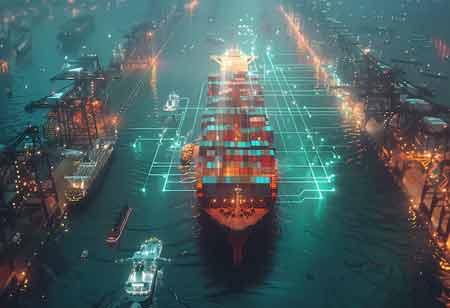THANK YOU FOR SUBSCRIBING
THANK YOU FOR SUBSCRIBING

By
Logistics Transportation Review | Thursday, November 13, 2025
Stay ahead of the industry with exclusive feature stories on the top companies, expert insights and the latest news delivered straight to your inbox. Subscribe today.
Fremont, CA: In recent years, container shipping—the foundation of international trade—has seen technical breakthroughs. The solutions ensure resilience in a supply chain environment that is becoming more complicated while improving efficiency, cutting costs, and promoting sustainability. Container shipping has become much more efficient because of automation. These days, automated port terminals use guided cars, straddle carriers, and autonomous cranes to move cargo fast and accurately. Sorting, stacking, and retrieving containers is done by robots, which lowers human error and increases operational effectiveness.
Platforms allow stakeholders to share data securely in real time. It reduces fraud, expedites customs processes, and streamlines documentation, saving time and money. The sensors ensure better cargo monitoring, particularly for perishable or sensitive goods. The container management system allows shippers to track refrigerated cargo in real-time, minimizing losses due to spoilage. AI and predictive analytics are used to optimize route planning, forecast demand, and enhance port operations. ML algorithms analyze weather patterns, port congestion, and fuel consumption to suggest optimal shipping routes.
Predictive analytics helps identify potential disruptions, enabling proactive measures. It is particularly valuable in mitigating risks like delays caused by geopolitical tensions or natural disasters. Digital twin technology creates virtual replicas of shipping vessels, containers, or ports. The models simulate real-world conditions, allowing companies to test and refine operations without risking actual assets. Environmental sustainability has become a priority, driving innovation in green shipping technologies.
Advances include alternative fuels like liquefied natural gas (LNG), hydrogen, and biofuels, as well as electrification of port equipment. Vessels incorporate energy-efficient designs like wind-assist propulsion systems and air lubrication technology. The deployment of 5G networks is enabling faster and more reliable communication between ships, ports, and logistics systems. Enhanced connectivity allows for real-time tracking and remote control of automated equipment. The improvement increases efficiency and improves safety by enabling swift responses to emergencies.
Drones are now being tested for delivering essential documents or small cargo directly to ships at sea. Autonomous trucks promise to make inland cargo transport more efficient and sustainable. Modern ports leverage data analytics and AI to optimize berth scheduling, reduce turnaround times, and improve cargo handling. Smart ports have integrated systems for traffic management, energy efficiency, and predictive maintenance. The container shipping industry is undergoing a technological renaissance.
The advancements, from automation and IoT to green technologies and blockchain, enhance operational efficiency, transparency, and sustainability. The innovations address current challenges and pave the way for a more resilient and future-ready logistics ecosystem.
I agree We use cookies on this website to enhance your user experience. By clicking any link on this page you are giving your consent for us to set cookies. More info





